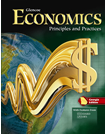Economics Principles and Practices © 2012 GeorgiaChapter 9:
Sources of Government RevenueChapter OverviewsSection 1: The Economics of Taxation
Taxes and other governmental revenues influence the economy by affecting resource allocation, consumer behavior, and the nation’s productivity and growth. The three criteria used to determine if a tax is effective are equity, simplicity, and efficiency. Furthermore, the benefit principle of taxation and the ability-to-pay principle of taxation are used to help decide the group or groups that should bear the burden of the tax. Finally, taxes can be proportional, progressive, and regressive, depending on the way the average tax per dollar changes as taxable income changes. Section 2: Federal, State, and Local Revenue Systems
There are four main sources of federal government revenues. The first is the individual income tax, a progressive tax administered through a payroll withholding system. The second largest component is FICA, which is levied on employers and employees equally to pay for Social Security and Medicare. The third is borrowing by the federal government. The corporate income tax is the fourth largest source. The excise tax—a tax on the manufacture or sale of selected items such as gasoline and liquor—is the fifth-largest source of federal government revenue. Other sources of federal revenue include estate taxes, gift taxes, customs duties, and user fees. State governments receive revenues in the form of sales taxes, intergovernmental revenues, individual income taxes, and employee retirement contributions. Local governments receive funds from state and federal governments, property taxes, utility providers, sales taxes, and other sources. Section 3: Current Tax Issues and Reforms
Major tax revision bills have been passed since 1980. The first reduced the progressiveness of the individual income tax and the second made it more proportional. The third, passed in 1993, made it more progressive again. The fourth, passed in 1997, provided wealthy individuals with significant tax relief for long-term investments, and provided modest tax relief for child and educational expenses. The fifth in 2001 focused on reducing the top four marginal tax brackets by significant percentages by 2006. Due to slow economic growth in 2002, the 2001 tax reform was accelerated. In 2008, in part because of a severe recession, the tax cuts of 2001 and 2003 did not continue.  | 






